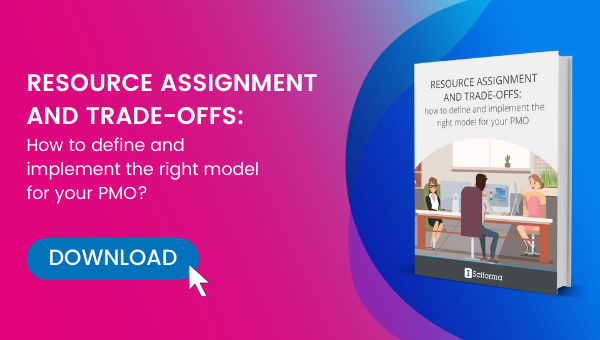
Similarly to “portfolio management” in a financial context, project portfolio management (usually shortened to PPM) aims to enable an organization to determine which projects and initiatives to pursue in order to achieve the most significant return on investment. It involves clarifying, prioritizing, and selecting the projects that are best aligned with the overall business objectives of the firm and determining the optimal way to sequence timelines in order to make the most out of the enterprise’s project activity. Here is a focus on the components of the PPM process that are keys to successful project portfolio management.
Key #1 to Successful Project Portfolio Management: Project Selection and Portfolio Building
In order to maximize the value and benefits that an organization can get from the projects it runs, it is essential to start by picking the right projects to launch: the firm’s precious resources should only be committed to projects that offer great return against the organization’s business objectives.
The Project Portfolio Management discipline provides a structured approach to help the firm to select the new projects it will invest in. To successfully meet project selection challenges, portfolio managers will consider the relative value of the different projects and programs that the business has the opportunity to pursue. The goal is to accurately assess the potential returns and risks of multiple competing projects in order to make the best trade-off decisions — instead of selecting investment projects based on gut feelings or personal preferences. Because it objectivizes the investment decisions, PPM-driven project selection makes it easier to align all stakeholders around a shared vision and common objectives.
Optimizing the make-up of project portfolios
In addition to identifying and prioritizing the most promising initiatives, Project Portfolio Management offers a methodical and structured approach to portfolio building and optimization. Although a portfolio typically brings together related projects and programs that can be managed more effectively as a group, it is key to diversify the project mix. Just like a portfolio of financial assets, your portfolio of projects should healthily balance programs and projects of diverse scopes, natures, and risk profiles. A goal is to strike the right equilibrium between risky ventures and business-as-usual projects and between long-term and shorter-term projects in order to optimize the portfolio’s overall risk profile and exposure.
The success of a Project Portfolio Management strategy hinges upon the firm’s ability to make decisions based on a clear and comprehensive view of the business drivers and directions on the one hand, and of the pipeline of projects on the other hand. It is of particular importance for portfolio management professionals to have a keen understanding of the interrelations and dependencies between projects (e.g. competition for shared resources, parent-child relationships, etc.), including insights on past and future investments across all applications and business areas.
Key #2 to Successful Project Portfolio Management: Monitoring Value and Risk
The value and risk analysis should be performed at the stage of project selection, but also revisited throughout the whole project life cycle. Unexpected events — whether external or internal to the organization — may occur and alter the conditions based on which you made your initial trade-offs. What more, the interrelations linking the various projects in a portfolio to one another will cause any shifts to snowball and impact the whole portfolio.
Hence the importance for project portfolio managers to oversee the execution of the projects and to perform the necessary adjustments in due time in order to ensure that the portfolio remains competitive and relevant against the organization’s vision, plans for the future, and business goals.
Focus on risk management
In order to see to it that project activity maximizes the chances for the business to achieve its goals and optimize the rate of successful delivery, a proper approach to risk management is key.
Portfolio managers or Project Management Offices should devise and implement specific policies and processes to identify, monitor, and prevent or remedy the various risk factors that might compromise project chances of delivering the expected outcomes and diminish the value of the portfolio. The risk management framework should include specific metrics to assess and gauge risk (such as cost vs return), with clearly set thresholds for project termination or reconsideration. It should also incorporate risk prevention, mitigation, and remediation strategies. Importantly, the risk management process should cover the full array of risks: financial, technological, operational, etc.
By analyzing project and portfolio value and risk in real time not only at the selection stage, but also throughout the life of projects, portfolio management professionals can ensure that their portfolios are and stay on track to creating maximum value for the organization.
Key #3 to Successful Project Portfolio Management: Fostering Organization-Wide Alignment
Another key mission of portfolio management leaders is to drive enhanced collaboration across project teams. Portfolios may encompass very diverse projects involving very different populations of stakeholders while still sharing the organization’s limited pool of resources. The objective and value-based approach of portfolio management to the selection and prioritization of projects helps to minimize conflicts and misunderstandings to give way to improved alignment across teams.
The Project Portfolio Management discipline also makes the connections between project-related activities and the long-term goals of the business apparent, further aligning all stakeholders around a common vision.
To effectively enable collaboration and alignment, project portfolio managers should implement adequate communication and collaboration tools. If not, acquiring a robust Project Portfolio Management software tool can produce great results towards seamless collaboration.
To learn more about the keys to successful Project Portfolio Management:
- Why do you need a PPM tool?
- Why is Project Portfolio Management important?
- What are the different types of Project Management Offices?








Isabelle Bouscatie
With many years as a EMEA Marketing Manager under her belt, Isabelle is presently in charge of Sciforma’s customer marketing and global events. She thrives in Sciforma’s dynamic, fast-paced digital environment and she enjoys working in direct contact with customers, who help her keep abreast of PPM challenges across organizations.